Marketing and Strategy Analysis of Coles Supermarket
VerifiedAdded on 2020/05/28
|13
|3681
|236
Report
AI Summary
This report provides a comprehensive marketing and strategy analysis of Coles, an Australian supermarket chain. It begins with an introduction to the company and the industry, followed by an evaluation of the market, including growth and profitability. The report then delves into the macro-environmental factors using PESTLE analysis, identifies major market segments, and examines segmentation, targeting, and positioning strategies. It also details the primary and secondary target markets, and analyzes the level of involvement of the primary segment in decision-making. A significant portion of the report is dedicated to competition and SWOT analysis, comparing Coles to Woolworths and creating a positioning map. The report concludes with a summary of the key findings and insights into Coles' marketing approach.
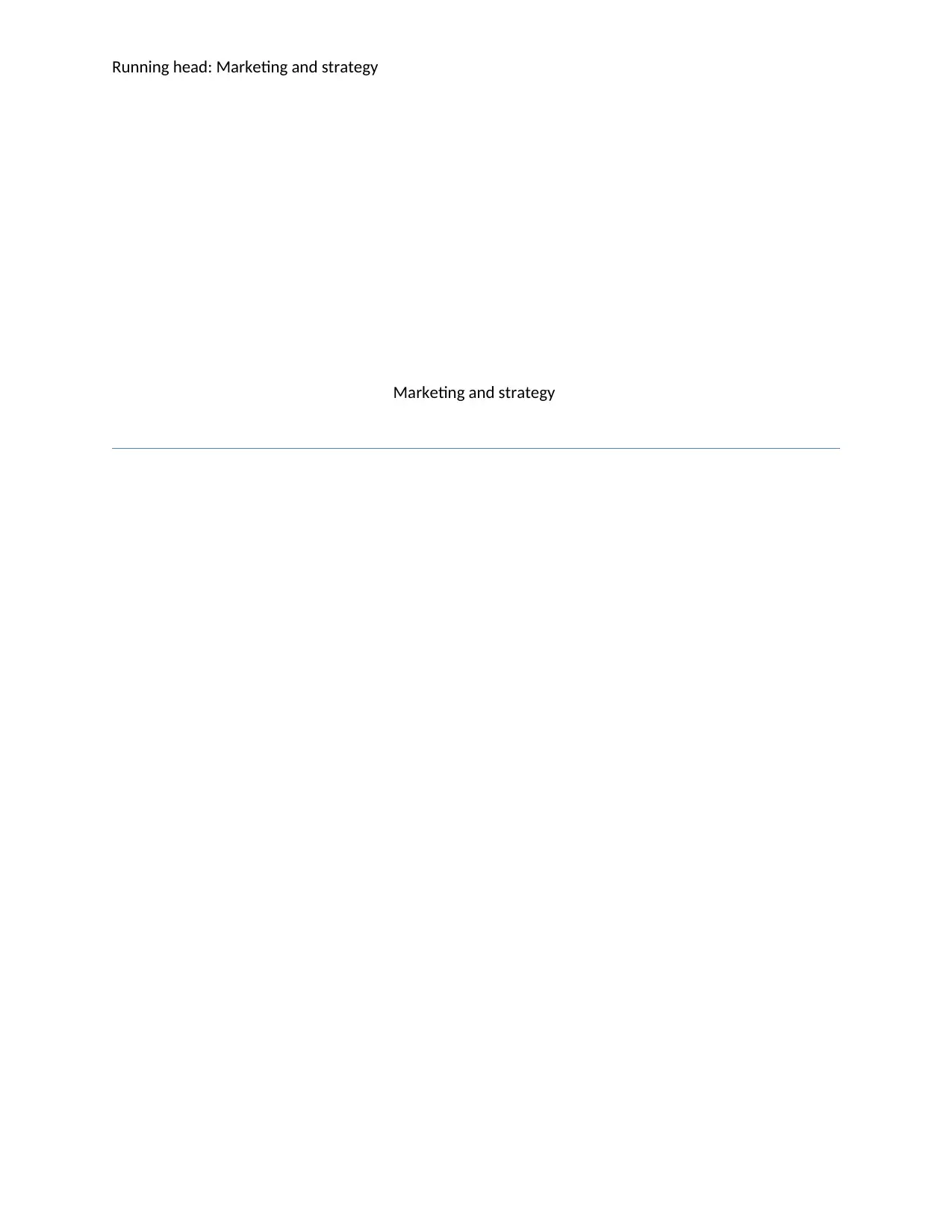
Running head: Marketing and strategy
Marketing and strategy
Marketing and strategy
Paraphrase This Document
Need a fresh take? Get an instant paraphrase of this document with our AI Paraphraser
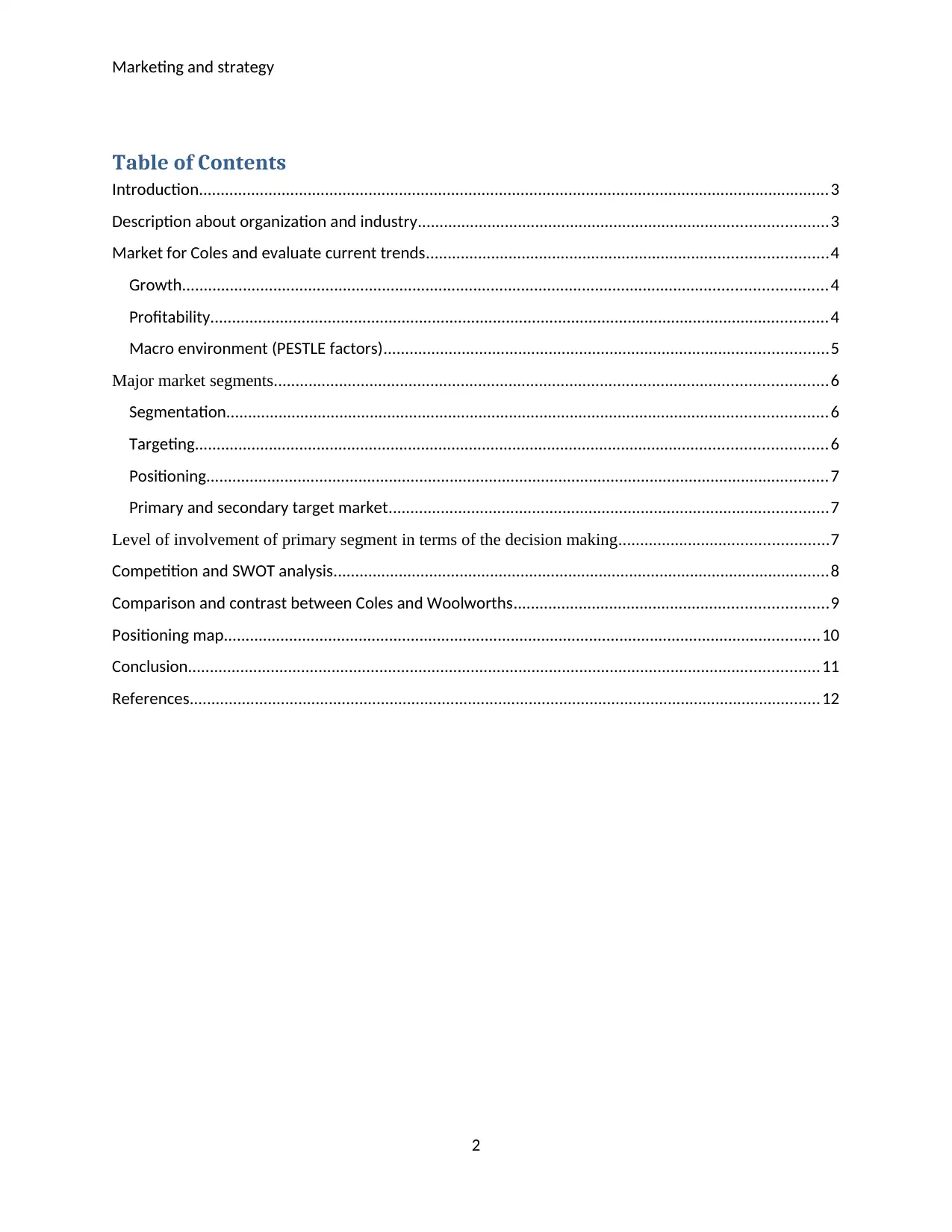
Marketing and strategy
Table of Contents
Introduction.................................................................................................................................................3
Description about organization and industry..............................................................................................3
Market for Coles and evaluate current trends............................................................................................4
Growth....................................................................................................................................................4
Profitability..............................................................................................................................................4
Macro environment (PESTLE factors)......................................................................................................5
Major market segments...............................................................................................................................6
Segmentation..........................................................................................................................................6
Targeting.................................................................................................................................................6
Positioning...............................................................................................................................................7
Primary and secondary target market.....................................................................................................7
Level of involvement of primary segment in terms of the decision making................................................7
Competition and SWOT analysis..................................................................................................................8
Comparison and contrast between Coles and Woolworths........................................................................9
Positioning map.........................................................................................................................................10
Conclusion.................................................................................................................................................11
References.................................................................................................................................................12
2
Table of Contents
Introduction.................................................................................................................................................3
Description about organization and industry..............................................................................................3
Market for Coles and evaluate current trends............................................................................................4
Growth....................................................................................................................................................4
Profitability..............................................................................................................................................4
Macro environment (PESTLE factors)......................................................................................................5
Major market segments...............................................................................................................................6
Segmentation..........................................................................................................................................6
Targeting.................................................................................................................................................6
Positioning...............................................................................................................................................7
Primary and secondary target market.....................................................................................................7
Level of involvement of primary segment in terms of the decision making................................................7
Competition and SWOT analysis..................................................................................................................8
Comparison and contrast between Coles and Woolworths........................................................................9
Positioning map.........................................................................................................................................10
Conclusion.................................................................................................................................................11
References.................................................................................................................................................12
2
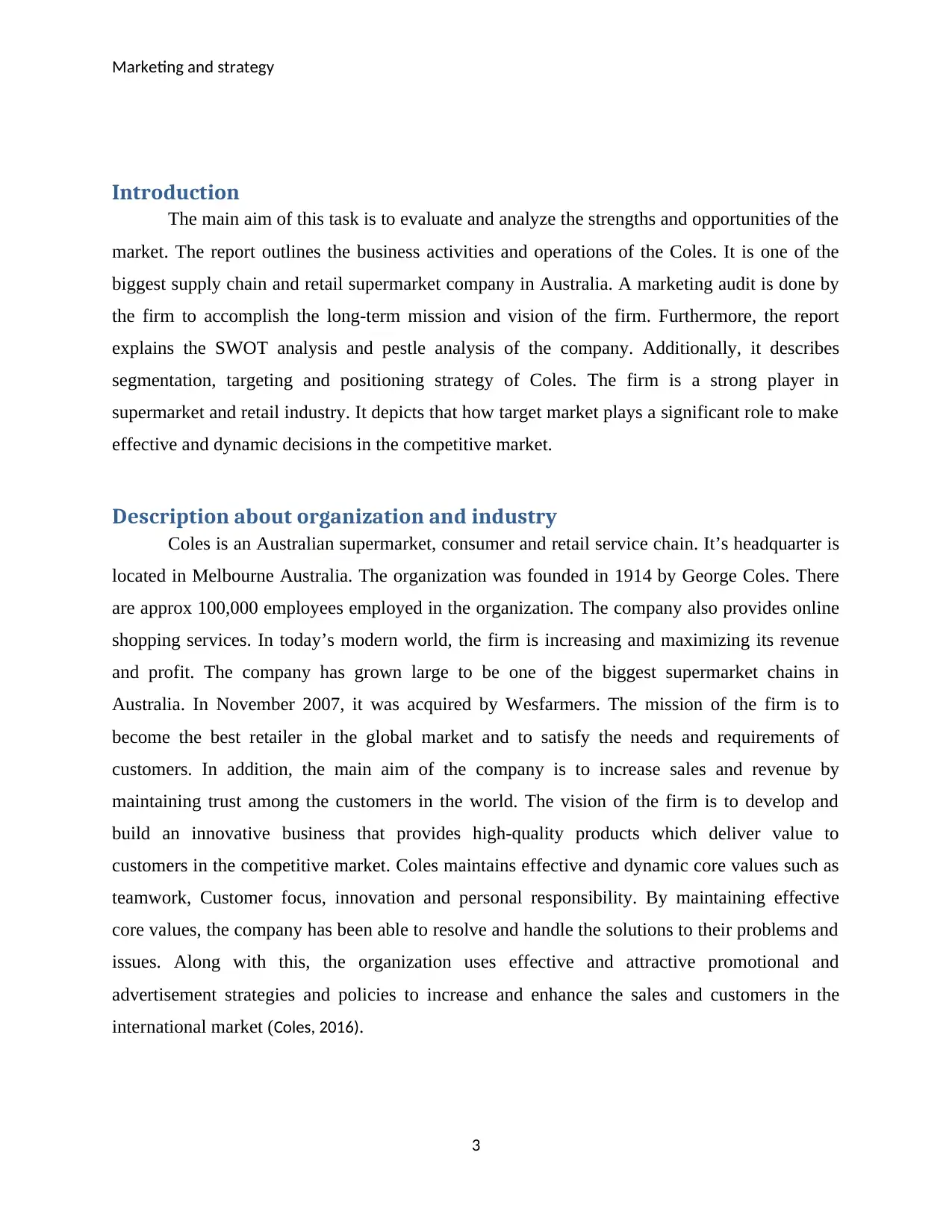
Marketing and strategy
Introduction
The main aim of this task is to evaluate and analyze the strengths and opportunities of the
market. The report outlines the business activities and operations of the Coles. It is one of the
biggest supply chain and retail supermarket company in Australia. A marketing audit is done by
the firm to accomplish the long-term mission and vision of the firm. Furthermore, the report
explains the SWOT analysis and pestle analysis of the company. Additionally, it describes
segmentation, targeting and positioning strategy of Coles. The firm is a strong player in
supermarket and retail industry. It depicts that how target market plays a significant role to make
effective and dynamic decisions in the competitive market.
Description about organization and industry
Coles is an Australian supermarket, consumer and retail service chain. It’s headquarter is
located in Melbourne Australia. The organization was founded in 1914 by George Coles. There
are approx 100,000 employees employed in the organization. The company also provides online
shopping services. In today’s modern world, the firm is increasing and maximizing its revenue
and profit. The company has grown large to be one of the biggest supermarket chains in
Australia. In November 2007, it was acquired by Wesfarmers. The mission of the firm is to
become the best retailer in the global market and to satisfy the needs and requirements of
customers. In addition, the main aim of the company is to increase sales and revenue by
maintaining trust among the customers in the world. The vision of the firm is to develop and
build an innovative business that provides high-quality products which deliver value to
customers in the competitive market. Coles maintains effective and dynamic core values such as
teamwork, Customer focus, innovation and personal responsibility. By maintaining effective
core values, the company has been able to resolve and handle the solutions to their problems and
issues. Along with this, the organization uses effective and attractive promotional and
advertisement strategies and policies to increase and enhance the sales and customers in the
international market (Coles, 2016).
3
Introduction
The main aim of this task is to evaluate and analyze the strengths and opportunities of the
market. The report outlines the business activities and operations of the Coles. It is one of the
biggest supply chain and retail supermarket company in Australia. A marketing audit is done by
the firm to accomplish the long-term mission and vision of the firm. Furthermore, the report
explains the SWOT analysis and pestle analysis of the company. Additionally, it describes
segmentation, targeting and positioning strategy of Coles. The firm is a strong player in
supermarket and retail industry. It depicts that how target market plays a significant role to make
effective and dynamic decisions in the competitive market.
Description about organization and industry
Coles is an Australian supermarket, consumer and retail service chain. It’s headquarter is
located in Melbourne Australia. The organization was founded in 1914 by George Coles. There
are approx 100,000 employees employed in the organization. The company also provides online
shopping services. In today’s modern world, the firm is increasing and maximizing its revenue
and profit. The company has grown large to be one of the biggest supermarket chains in
Australia. In November 2007, it was acquired by Wesfarmers. The mission of the firm is to
become the best retailer in the global market and to satisfy the needs and requirements of
customers. In addition, the main aim of the company is to increase sales and revenue by
maintaining trust among the customers in the world. The vision of the firm is to develop and
build an innovative business that provides high-quality products which deliver value to
customers in the competitive market. Coles maintains effective and dynamic core values such as
teamwork, Customer focus, innovation and personal responsibility. By maintaining effective
core values, the company has been able to resolve and handle the solutions to their problems and
issues. Along with this, the organization uses effective and attractive promotional and
advertisement strategies and policies to increase and enhance the sales and customers in the
international market (Coles, 2016).
3
⊘ This is a preview!⊘
Do you want full access?
Subscribe today to unlock all pages.

Trusted by 1+ million students worldwide
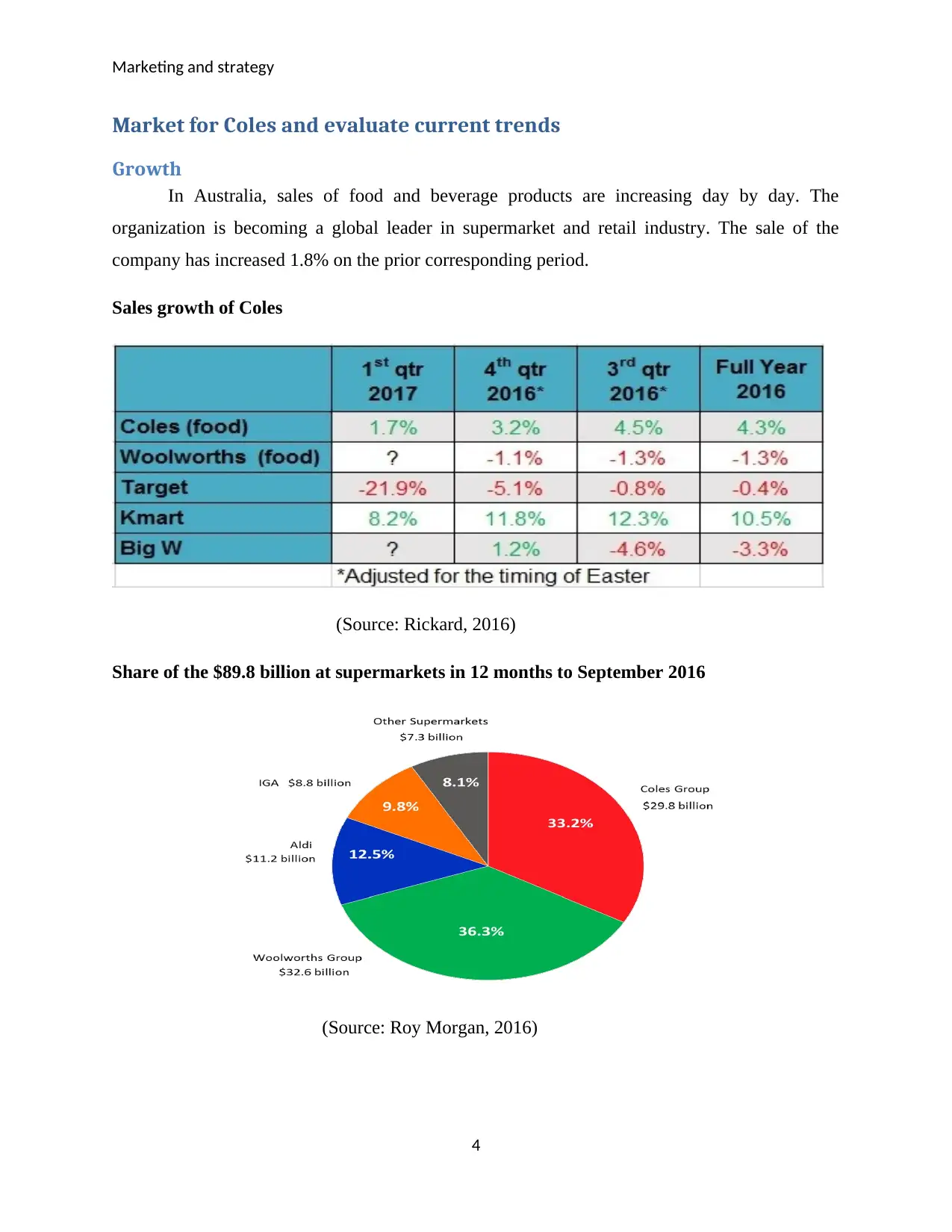
Marketing and strategy
Market for Coles and evaluate current trends
Growth
In Australia, sales of food and beverage products are increasing day by day. The
organization is becoming a global leader in supermarket and retail industry. The sale of the
company has increased 1.8% on the prior corresponding period.
Sales growth of Coles
(Source: Rickard, 2016)
Share of the $89.8 billion at supermarkets in 12 months to September 2016
(Source: Roy Morgan, 2016)
4
Market for Coles and evaluate current trends
Growth
In Australia, sales of food and beverage products are increasing day by day. The
organization is becoming a global leader in supermarket and retail industry. The sale of the
company has increased 1.8% on the prior corresponding period.
Sales growth of Coles
(Source: Rickard, 2016)
Share of the $89.8 billion at supermarkets in 12 months to September 2016
(Source: Roy Morgan, 2016)
4
Paraphrase This Document
Need a fresh take? Get an instant paraphrase of this document with our AI Paraphraser
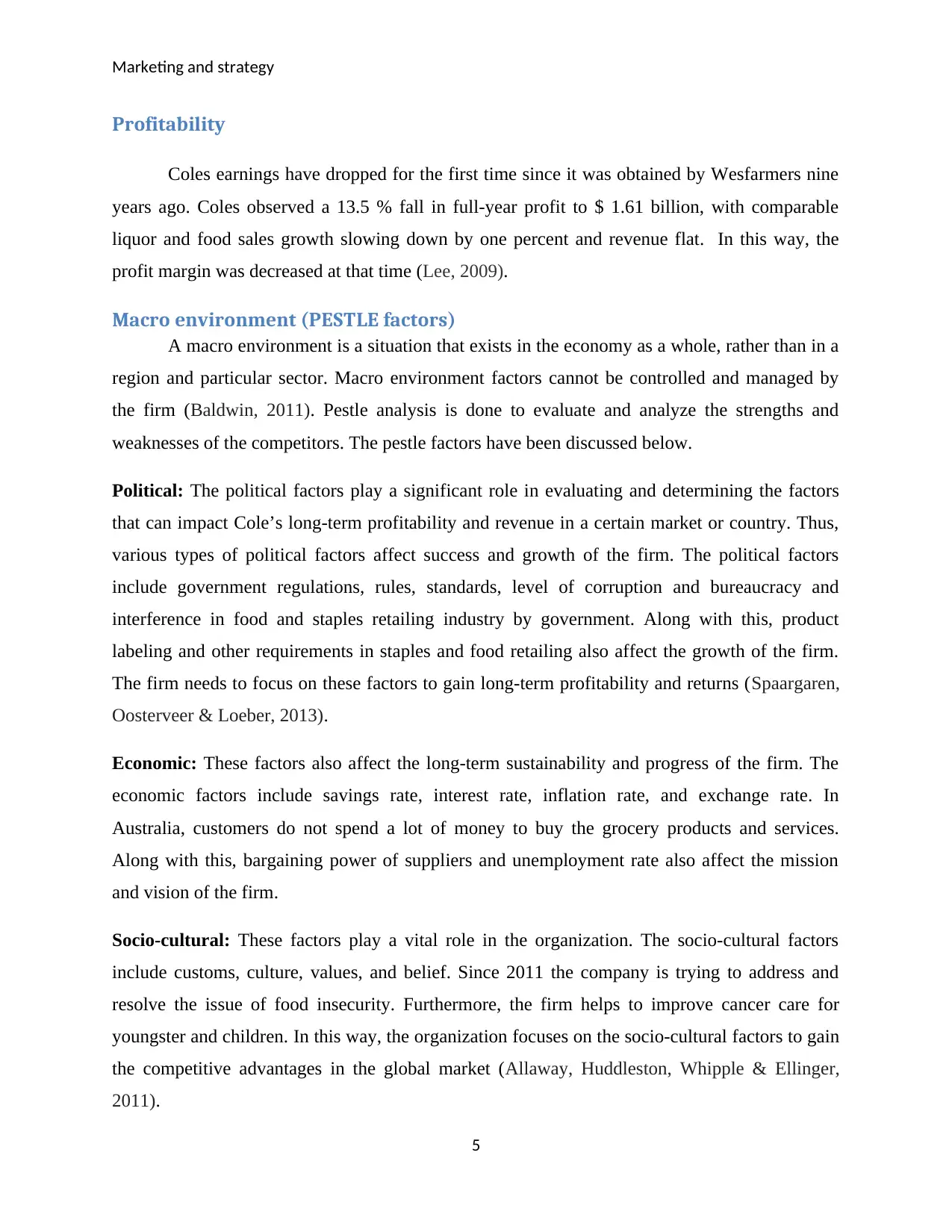
Marketing and strategy
Profitability
Coles earnings have dropped for the first time since it was obtained by Wesfarmers nine
years ago. Coles observed a 13.5 % fall in full-year profit to $ 1.61 billion, with comparable
liquor and food sales growth slowing down by one percent and revenue flat. In this way, the
profit margin was decreased at that time (Lee, 2009).
Macro environment (PESTLE factors)
A macro environment is a situation that exists in the economy as a whole, rather than in a
region and particular sector. Macro environment factors cannot be controlled and managed by
the firm (Baldwin, 2011). Pestle analysis is done to evaluate and analyze the strengths and
weaknesses of the competitors. The pestle factors have been discussed below.
Political: The political factors play a significant role in evaluating and determining the factors
that can impact Cole’s long-term profitability and revenue in a certain market or country. Thus,
various types of political factors affect success and growth of the firm. The political factors
include government regulations, rules, standards, level of corruption and bureaucracy and
interference in food and staples retailing industry by government. Along with this, product
labeling and other requirements in staples and food retailing also affect the growth of the firm.
The firm needs to focus on these factors to gain long-term profitability and returns (Spaargaren,
Oosterveer & Loeber, 2013).
Economic: These factors also affect the long-term sustainability and progress of the firm. The
economic factors include savings rate, interest rate, inflation rate, and exchange rate. In
Australia, customers do not spend a lot of money to buy the grocery products and services.
Along with this, bargaining power of suppliers and unemployment rate also affect the mission
and vision of the firm.
Socio-cultural: These factors play a vital role in the organization. The socio-cultural factors
include customs, culture, values, and belief. Since 2011 the company is trying to address and
resolve the issue of food insecurity. Furthermore, the firm helps to improve cancer care for
youngster and children. In this way, the organization focuses on the socio-cultural factors to gain
the competitive advantages in the global market (Allaway, Huddleston, Whipple & Ellinger,
2011).
5
Profitability
Coles earnings have dropped for the first time since it was obtained by Wesfarmers nine
years ago. Coles observed a 13.5 % fall in full-year profit to $ 1.61 billion, with comparable
liquor and food sales growth slowing down by one percent and revenue flat. In this way, the
profit margin was decreased at that time (Lee, 2009).
Macro environment (PESTLE factors)
A macro environment is a situation that exists in the economy as a whole, rather than in a
region and particular sector. Macro environment factors cannot be controlled and managed by
the firm (Baldwin, 2011). Pestle analysis is done to evaluate and analyze the strengths and
weaknesses of the competitors. The pestle factors have been discussed below.
Political: The political factors play a significant role in evaluating and determining the factors
that can impact Cole’s long-term profitability and revenue in a certain market or country. Thus,
various types of political factors affect success and growth of the firm. The political factors
include government regulations, rules, standards, level of corruption and bureaucracy and
interference in food and staples retailing industry by government. Along with this, product
labeling and other requirements in staples and food retailing also affect the growth of the firm.
The firm needs to focus on these factors to gain long-term profitability and returns (Spaargaren,
Oosterveer & Loeber, 2013).
Economic: These factors also affect the long-term sustainability and progress of the firm. The
economic factors include savings rate, interest rate, inflation rate, and exchange rate. In
Australia, customers do not spend a lot of money to buy the grocery products and services.
Along with this, bargaining power of suppliers and unemployment rate also affect the mission
and vision of the firm.
Socio-cultural: These factors play a vital role in the organization. The socio-cultural factors
include customs, culture, values, and belief. Since 2011 the company is trying to address and
resolve the issue of food insecurity. Furthermore, the firm helps to improve cancer care for
youngster and children. In this way, the organization focuses on the socio-cultural factors to gain
the competitive advantages in the global market (Allaway, Huddleston, Whipple & Ellinger,
2011).
5

Marketing and strategy
Technological: The firm is increasing the use of the internet to provide various products and
services to the customers. Apart from this, less payment facilities and self-check out facilities are
being provided by the organization. It uses cloud infrastructure and innovative technologies to
attract and retain more consumers in the competitive market.
Legal: There are several laws and regulations also have a direct impact on the efficiency and
performance of the firm. The legal factors include discrimination law, copyright, intellectual
property law and antitrust law. Therefore, the firm focuses on these factors to stand out against
the competitors.
Environmental: Coles uses sustainable products and eco-friendly supermarkets to increase the
number of customers in the global market. Additionally, different market norms and
environmental standards also affect the profitability and returns of an organization. The firm also
focuses on the weather, environmental pollution and climate change (Baker, 2012).
Major market segments
The market plays a significant role in the organization to increase and maximize the sales
of the company. It also helps to accomplish the goals and objectives of the firm (Grewal,
Ailawadi, Gauri, Hall, Kopalle & Robertson, 2011). The major market segments of Coles have
been discussed below.
Segmentation
The firm divides its products on the basis of demographic, psychographic, geographic,
lifestyle and behavior of people. The firm focuses on retail and departmental stores to earn more
revenue and returns. Along with this, the company also monitors and evaluates the needs,
requirements, desires, and choices of the consumers to gain competitive benefits in the market
(Teller, Kotzab, & Grant, 2012).
Targeting
The target group includes middle class and premium Australian households that help to
maximize the outputs and returns. In targeting strategy, the company focuses on the size and
nature of the segment and group. In addition, the organization differentiates its products from
6
Technological: The firm is increasing the use of the internet to provide various products and
services to the customers. Apart from this, less payment facilities and self-check out facilities are
being provided by the organization. It uses cloud infrastructure and innovative technologies to
attract and retain more consumers in the competitive market.
Legal: There are several laws and regulations also have a direct impact on the efficiency and
performance of the firm. The legal factors include discrimination law, copyright, intellectual
property law and antitrust law. Therefore, the firm focuses on these factors to stand out against
the competitors.
Environmental: Coles uses sustainable products and eco-friendly supermarkets to increase the
number of customers in the global market. Additionally, different market norms and
environmental standards also affect the profitability and returns of an organization. The firm also
focuses on the weather, environmental pollution and climate change (Baker, 2012).
Major market segments
The market plays a significant role in the organization to increase and maximize the sales
of the company. It also helps to accomplish the goals and objectives of the firm (Grewal,
Ailawadi, Gauri, Hall, Kopalle & Robertson, 2011). The major market segments of Coles have
been discussed below.
Segmentation
The firm divides its products on the basis of demographic, psychographic, geographic,
lifestyle and behavior of people. The firm focuses on retail and departmental stores to earn more
revenue and returns. Along with this, the company also monitors and evaluates the needs,
requirements, desires, and choices of the consumers to gain competitive benefits in the market
(Teller, Kotzab, & Grant, 2012).
Targeting
The target group includes middle class and premium Australian households that help to
maximize the outputs and returns. In targeting strategy, the company focuses on the size and
nature of the segment and group. In addition, the organization differentiates its products from
6
⊘ This is a preview!⊘
Do you want full access?
Subscribe today to unlock all pages.

Trusted by 1+ million students worldwide
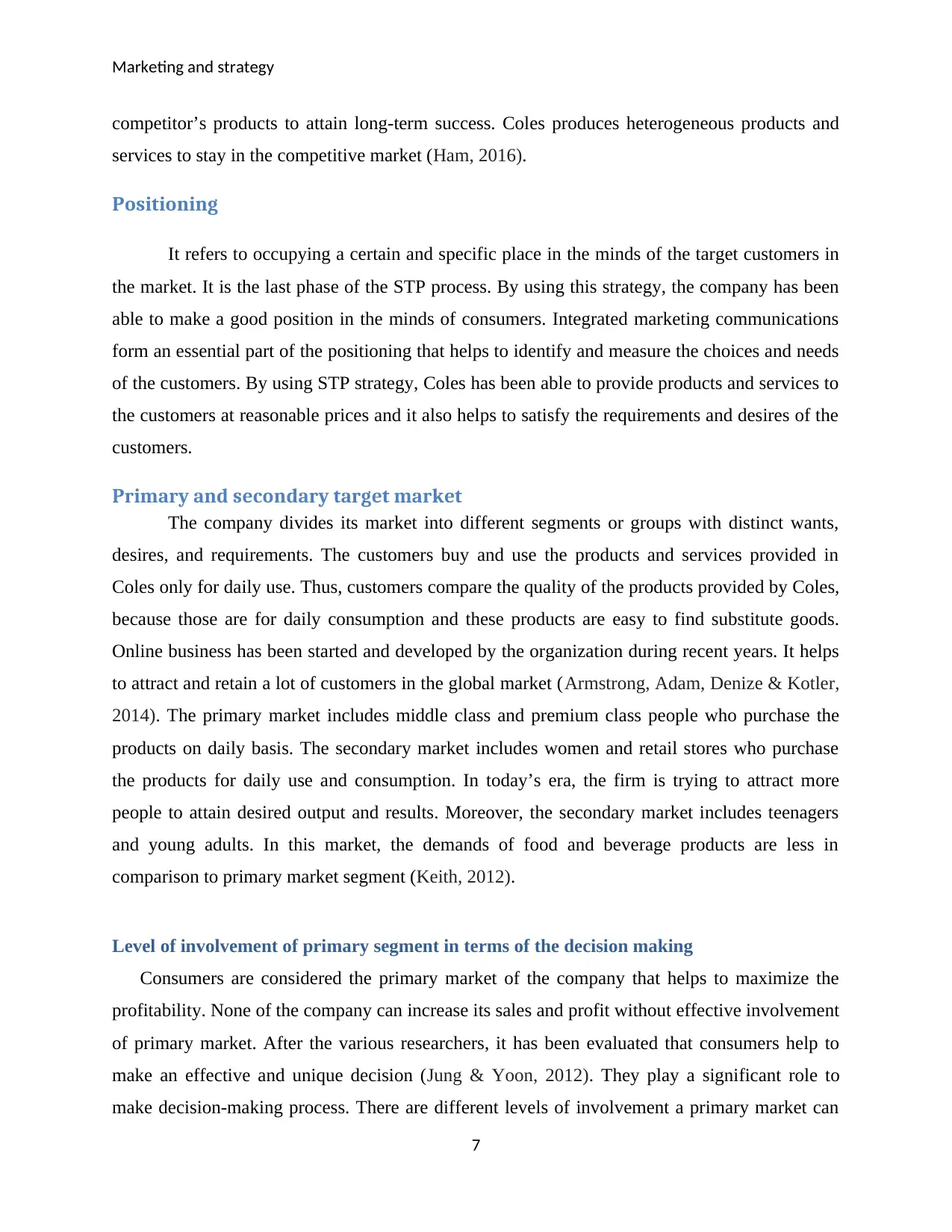
Marketing and strategy
competitor’s products to attain long-term success. Coles produces heterogeneous products and
services to stay in the competitive market (Ham, 2016).
Positioning
It refers to occupying a certain and specific place in the minds of the target customers in
the market. It is the last phase of the STP process. By using this strategy, the company has been
able to make a good position in the minds of consumers. Integrated marketing communications
form an essential part of the positioning that helps to identify and measure the choices and needs
of the customers. By using STP strategy, Coles has been able to provide products and services to
the customers at reasonable prices and it also helps to satisfy the requirements and desires of the
customers.
Primary and secondary target market
The company divides its market into different segments or groups with distinct wants,
desires, and requirements. The customers buy and use the products and services provided in
Coles only for daily use. Thus, customers compare the quality of the products provided by Coles,
because those are for daily consumption and these products are easy to find substitute goods.
Online business has been started and developed by the organization during recent years. It helps
to attract and retain a lot of customers in the global market (Armstrong, Adam, Denize & Kotler,
2014). The primary market includes middle class and premium class people who purchase the
products on daily basis. The secondary market includes women and retail stores who purchase
the products for daily use and consumption. In today’s era, the firm is trying to attract more
people to attain desired output and results. Moreover, the secondary market includes teenagers
and young adults. In this market, the demands of food and beverage products are less in
comparison to primary market segment (Keith, 2012).
Level of involvement of primary segment in terms of the decision making
Consumers are considered the primary market of the company that helps to maximize the
profitability. None of the company can increase its sales and profit without effective involvement
of primary market. After the various researchers, it has been evaluated that consumers help to
make an effective and unique decision (Jung & Yoon, 2012). They play a significant role to
make decision-making process. There are different levels of involvement a primary market can
7
competitor’s products to attain long-term success. Coles produces heterogeneous products and
services to stay in the competitive market (Ham, 2016).
Positioning
It refers to occupying a certain and specific place in the minds of the target customers in
the market. It is the last phase of the STP process. By using this strategy, the company has been
able to make a good position in the minds of consumers. Integrated marketing communications
form an essential part of the positioning that helps to identify and measure the choices and needs
of the customers. By using STP strategy, Coles has been able to provide products and services to
the customers at reasonable prices and it also helps to satisfy the requirements and desires of the
customers.
Primary and secondary target market
The company divides its market into different segments or groups with distinct wants,
desires, and requirements. The customers buy and use the products and services provided in
Coles only for daily use. Thus, customers compare the quality of the products provided by Coles,
because those are for daily consumption and these products are easy to find substitute goods.
Online business has been started and developed by the organization during recent years. It helps
to attract and retain a lot of customers in the global market (Armstrong, Adam, Denize & Kotler,
2014). The primary market includes middle class and premium class people who purchase the
products on daily basis. The secondary market includes women and retail stores who purchase
the products for daily use and consumption. In today’s era, the firm is trying to attract more
people to attain desired output and results. Moreover, the secondary market includes teenagers
and young adults. In this market, the demands of food and beverage products are less in
comparison to primary market segment (Keith, 2012).
Level of involvement of primary segment in terms of the decision making
Consumers are considered the primary market of the company that helps to maximize the
profitability. None of the company can increase its sales and profit without effective involvement
of primary market. After the various researchers, it has been evaluated that consumers help to
make an effective and unique decision (Jung & Yoon, 2012). They play a significant role to
make decision-making process. There are different levels of involvement a primary market can
7
Paraphrase This Document
Need a fresh take? Get an instant paraphrase of this document with our AI Paraphraser
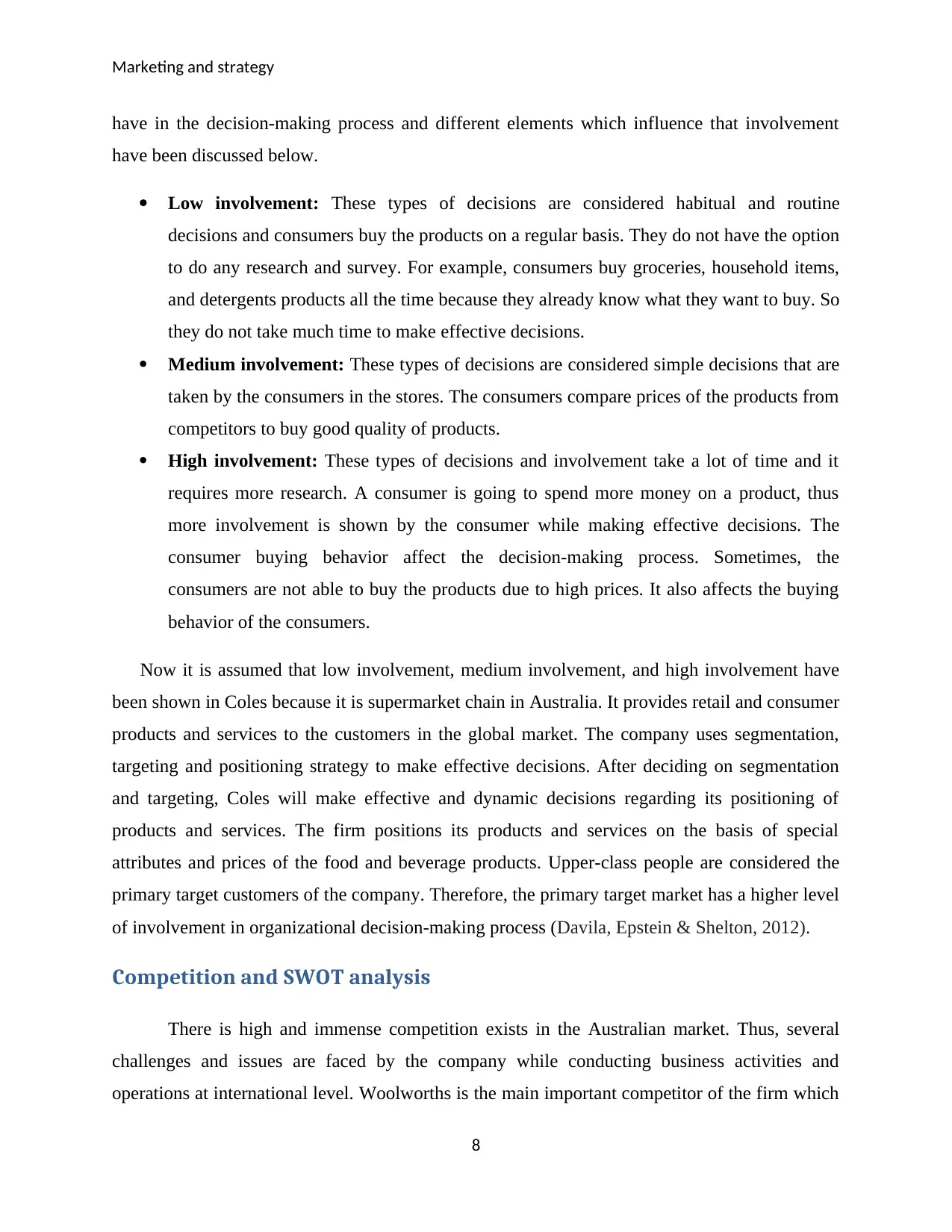
Marketing and strategy
have in the decision-making process and different elements which influence that involvement
have been discussed below.
Low involvement: These types of decisions are considered habitual and routine
decisions and consumers buy the products on a regular basis. They do not have the option
to do any research and survey. For example, consumers buy groceries, household items,
and detergents products all the time because they already know what they want to buy. So
they do not take much time to make effective decisions.
Medium involvement: These types of decisions are considered simple decisions that are
taken by the consumers in the stores. The consumers compare prices of the products from
competitors to buy good quality of products.
High involvement: These types of decisions and involvement take a lot of time and it
requires more research. A consumer is going to spend more money on a product, thus
more involvement is shown by the consumer while making effective decisions. The
consumer buying behavior affect the decision-making process. Sometimes, the
consumers are not able to buy the products due to high prices. It also affects the buying
behavior of the consumers.
Now it is assumed that low involvement, medium involvement, and high involvement have
been shown in Coles because it is supermarket chain in Australia. It provides retail and consumer
products and services to the customers in the global market. The company uses segmentation,
targeting and positioning strategy to make effective decisions. After deciding on segmentation
and targeting, Coles will make effective and dynamic decisions regarding its positioning of
products and services. The firm positions its products and services on the basis of special
attributes and prices of the food and beverage products. Upper-class people are considered the
primary target customers of the company. Therefore, the primary target market has a higher level
of involvement in organizational decision-making process (Davila, Epstein & Shelton, 2012).
Competition and SWOT analysis
There is high and immense competition exists in the Australian market. Thus, several
challenges and issues are faced by the company while conducting business activities and
operations at international level. Woolworths is the main important competitor of the firm which
8
have in the decision-making process and different elements which influence that involvement
have been discussed below.
Low involvement: These types of decisions are considered habitual and routine
decisions and consumers buy the products on a regular basis. They do not have the option
to do any research and survey. For example, consumers buy groceries, household items,
and detergents products all the time because they already know what they want to buy. So
they do not take much time to make effective decisions.
Medium involvement: These types of decisions are considered simple decisions that are
taken by the consumers in the stores. The consumers compare prices of the products from
competitors to buy good quality of products.
High involvement: These types of decisions and involvement take a lot of time and it
requires more research. A consumer is going to spend more money on a product, thus
more involvement is shown by the consumer while making effective decisions. The
consumer buying behavior affect the decision-making process. Sometimes, the
consumers are not able to buy the products due to high prices. It also affects the buying
behavior of the consumers.
Now it is assumed that low involvement, medium involvement, and high involvement have
been shown in Coles because it is supermarket chain in Australia. It provides retail and consumer
products and services to the customers in the global market. The company uses segmentation,
targeting and positioning strategy to make effective decisions. After deciding on segmentation
and targeting, Coles will make effective and dynamic decisions regarding its positioning of
products and services. The firm positions its products and services on the basis of special
attributes and prices of the food and beverage products. Upper-class people are considered the
primary target customers of the company. Therefore, the primary target market has a higher level
of involvement in organizational decision-making process (Davila, Epstein & Shelton, 2012).
Competition and SWOT analysis
There is high and immense competition exists in the Australian market. Thus, several
challenges and issues are faced by the company while conducting business activities and
operations at international level. Woolworths is the main important competitor of the firm which
8
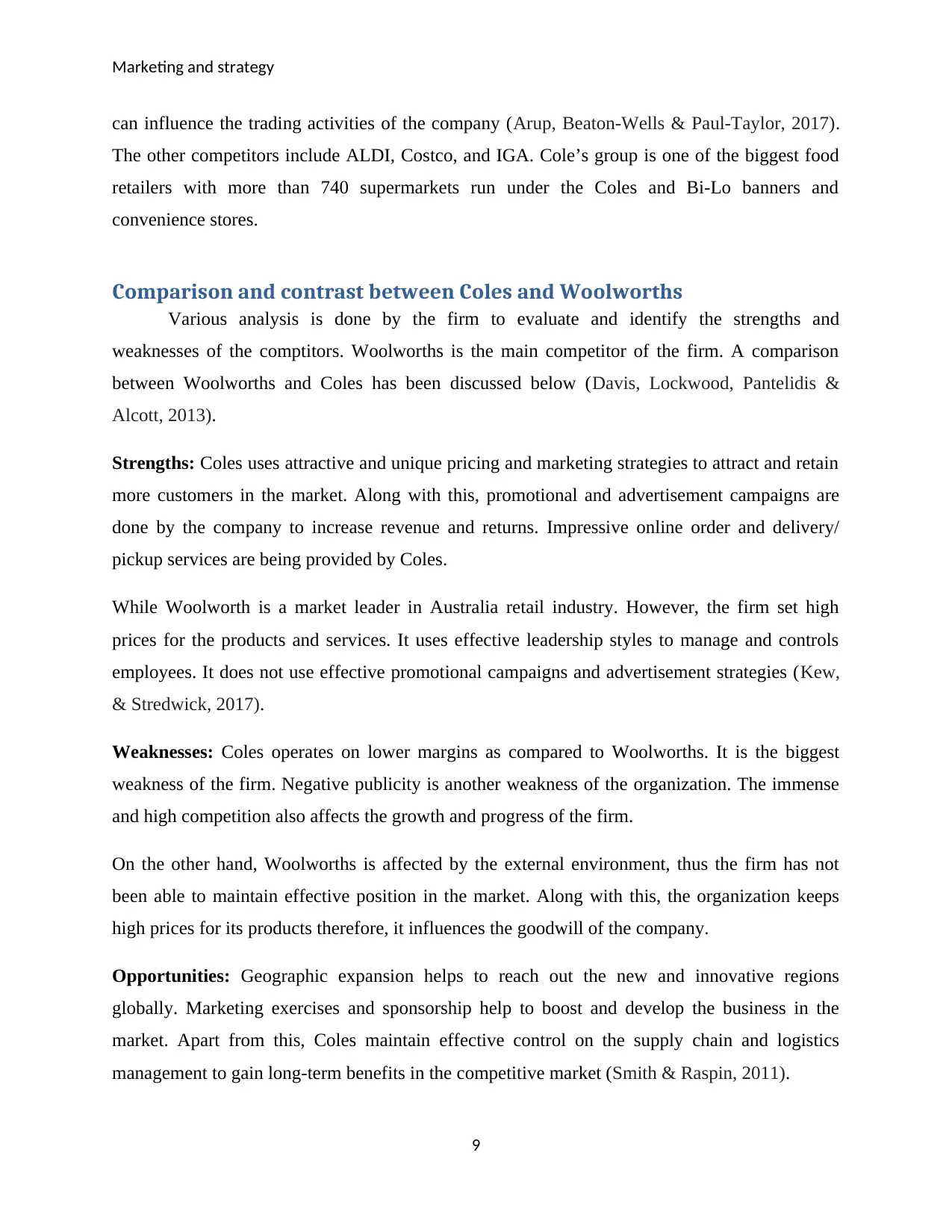
Marketing and strategy
can influence the trading activities of the company (Arup, Beaton-Wells & Paul-Taylor, 2017).
The other competitors include ALDI, Costco, and IGA. Cole’s group is one of the biggest food
retailers with more than 740 supermarkets run under the Coles and Bi-Lo banners and
convenience stores.
Comparison and contrast between Coles and Woolworths
Various analysis is done by the firm to evaluate and identify the strengths and
weaknesses of the comptitors. Woolworths is the main competitor of the firm. A comparison
between Woolworths and Coles has been discussed below (Davis, Lockwood, Pantelidis &
Alcott, 2013).
Strengths: Coles uses attractive and unique pricing and marketing strategies to attract and retain
more customers in the market. Along with this, promotional and advertisement campaigns are
done by the company to increase revenue and returns. Impressive online order and delivery/
pickup services are being provided by Coles.
While Woolworth is a market leader in Australia retail industry. However, the firm set high
prices for the products and services. It uses effective leadership styles to manage and controls
employees. It does not use effective promotional campaigns and advertisement strategies (Kew,
& Stredwick, 2017).
Weaknesses: Coles operates on lower margins as compared to Woolworths. It is the biggest
weakness of the firm. Negative publicity is another weakness of the organization. The immense
and high competition also affects the growth and progress of the firm.
On the other hand, Woolworths is affected by the external environment, thus the firm has not
been able to maintain effective position in the market. Along with this, the organization keeps
high prices for its products therefore, it influences the goodwill of the company.
Opportunities: Geographic expansion helps to reach out the new and innovative regions
globally. Marketing exercises and sponsorship help to boost and develop the business in the
market. Apart from this, Coles maintain effective control on the supply chain and logistics
management to gain long-term benefits in the competitive market (Smith & Raspin, 2011).
9
can influence the trading activities of the company (Arup, Beaton-Wells & Paul-Taylor, 2017).
The other competitors include ALDI, Costco, and IGA. Cole’s group is one of the biggest food
retailers with more than 740 supermarkets run under the Coles and Bi-Lo banners and
convenience stores.
Comparison and contrast between Coles and Woolworths
Various analysis is done by the firm to evaluate and identify the strengths and
weaknesses of the comptitors. Woolworths is the main competitor of the firm. A comparison
between Woolworths and Coles has been discussed below (Davis, Lockwood, Pantelidis &
Alcott, 2013).
Strengths: Coles uses attractive and unique pricing and marketing strategies to attract and retain
more customers in the market. Along with this, promotional and advertisement campaigns are
done by the company to increase revenue and returns. Impressive online order and delivery/
pickup services are being provided by Coles.
While Woolworth is a market leader in Australia retail industry. However, the firm set high
prices for the products and services. It uses effective leadership styles to manage and controls
employees. It does not use effective promotional campaigns and advertisement strategies (Kew,
& Stredwick, 2017).
Weaknesses: Coles operates on lower margins as compared to Woolworths. It is the biggest
weakness of the firm. Negative publicity is another weakness of the organization. The immense
and high competition also affects the growth and progress of the firm.
On the other hand, Woolworths is affected by the external environment, thus the firm has not
been able to maintain effective position in the market. Along with this, the organization keeps
high prices for its products therefore, it influences the goodwill of the company.
Opportunities: Geographic expansion helps to reach out the new and innovative regions
globally. Marketing exercises and sponsorship help to boost and develop the business in the
market. Apart from this, Coles maintain effective control on the supply chain and logistics
management to gain long-term benefits in the competitive market (Smith & Raspin, 2011).
9
⊘ This is a preview!⊘
Do you want full access?
Subscribe today to unlock all pages.

Trusted by 1+ million students worldwide
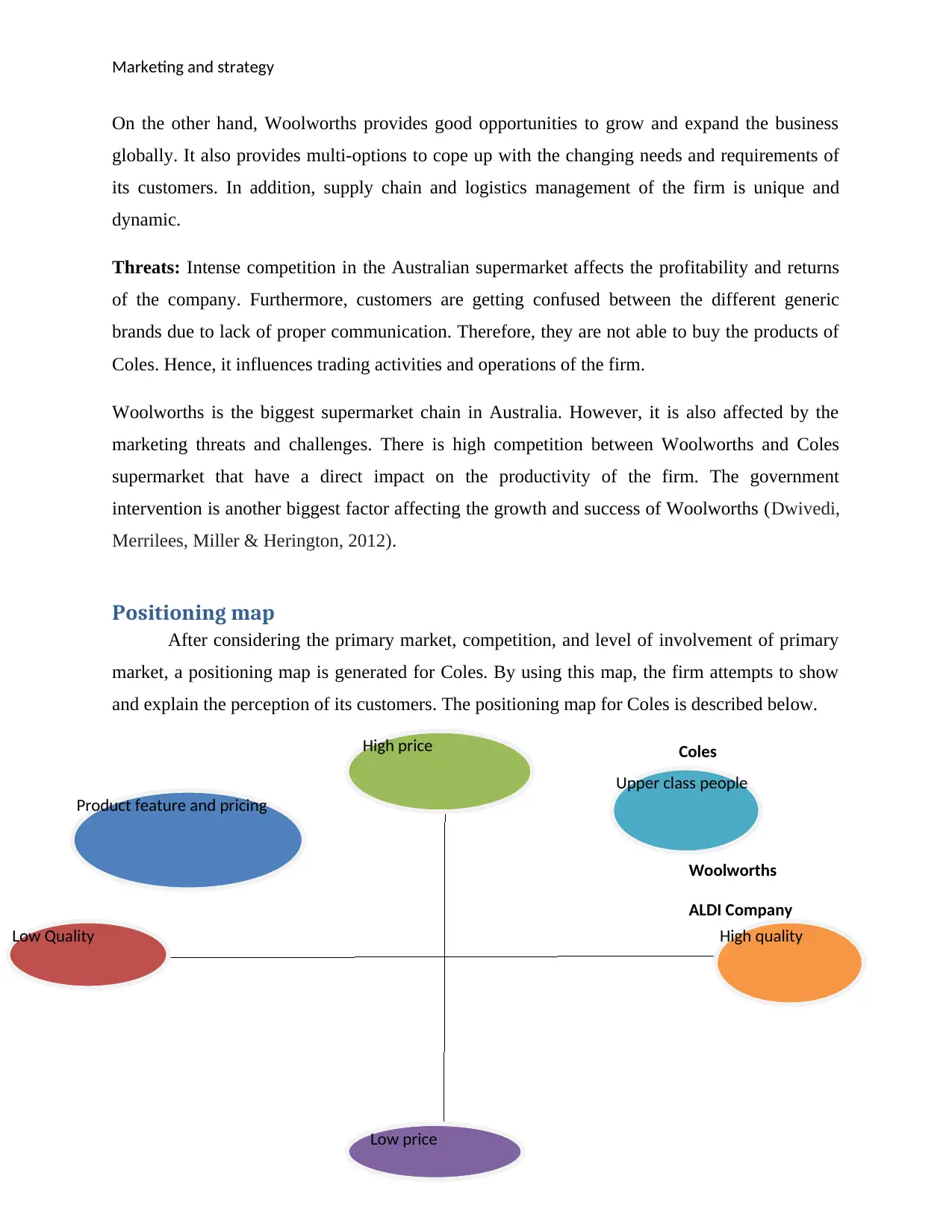
Marketing and strategy
On the other hand, Woolworths provides good opportunities to grow and expand the business
globally. It also provides multi-options to cope up with the changing needs and requirements of
its customers. In addition, supply chain and logistics management of the firm is unique and
dynamic.
Threats: Intense competition in the Australian supermarket affects the profitability and returns
of the company. Furthermore, customers are getting confused between the different generic
brands due to lack of proper communication. Therefore, they are not able to buy the products of
Coles. Hence, it influences trading activities and operations of the firm.
Woolworths is the biggest supermarket chain in Australia. However, it is also affected by the
marketing threats and challenges. There is high competition between Woolworths and Coles
supermarket that have a direct impact on the productivity of the firm. The government
intervention is another biggest factor affecting the growth and success of Woolworths (Dwivedi,
Merrilees, Miller & Herington, 2012).
Positioning map
After considering the primary market, competition, and level of involvement of primary
market, a positioning map is generated for Coles. By using this map, the firm attempts to show
and explain the perception of its customers. The positioning map for Coles is described below.
Coles
Woolworths
ALDI Company
10
High price
Low price
Low Quality High quality
Product feature and pricing
Upper class people
On the other hand, Woolworths provides good opportunities to grow and expand the business
globally. It also provides multi-options to cope up with the changing needs and requirements of
its customers. In addition, supply chain and logistics management of the firm is unique and
dynamic.
Threats: Intense competition in the Australian supermarket affects the profitability and returns
of the company. Furthermore, customers are getting confused between the different generic
brands due to lack of proper communication. Therefore, they are not able to buy the products of
Coles. Hence, it influences trading activities and operations of the firm.
Woolworths is the biggest supermarket chain in Australia. However, it is also affected by the
marketing threats and challenges. There is high competition between Woolworths and Coles
supermarket that have a direct impact on the productivity of the firm. The government
intervention is another biggest factor affecting the growth and success of Woolworths (Dwivedi,
Merrilees, Miller & Herington, 2012).
Positioning map
After considering the primary market, competition, and level of involvement of primary
market, a positioning map is generated for Coles. By using this map, the firm attempts to show
and explain the perception of its customers. The positioning map for Coles is described below.
Coles
Woolworths
ALDI Company
10
High price
Low price
Low Quality High quality
Product feature and pricing
Upper class people
Paraphrase This Document
Need a fresh take? Get an instant paraphrase of this document with our AI Paraphraser
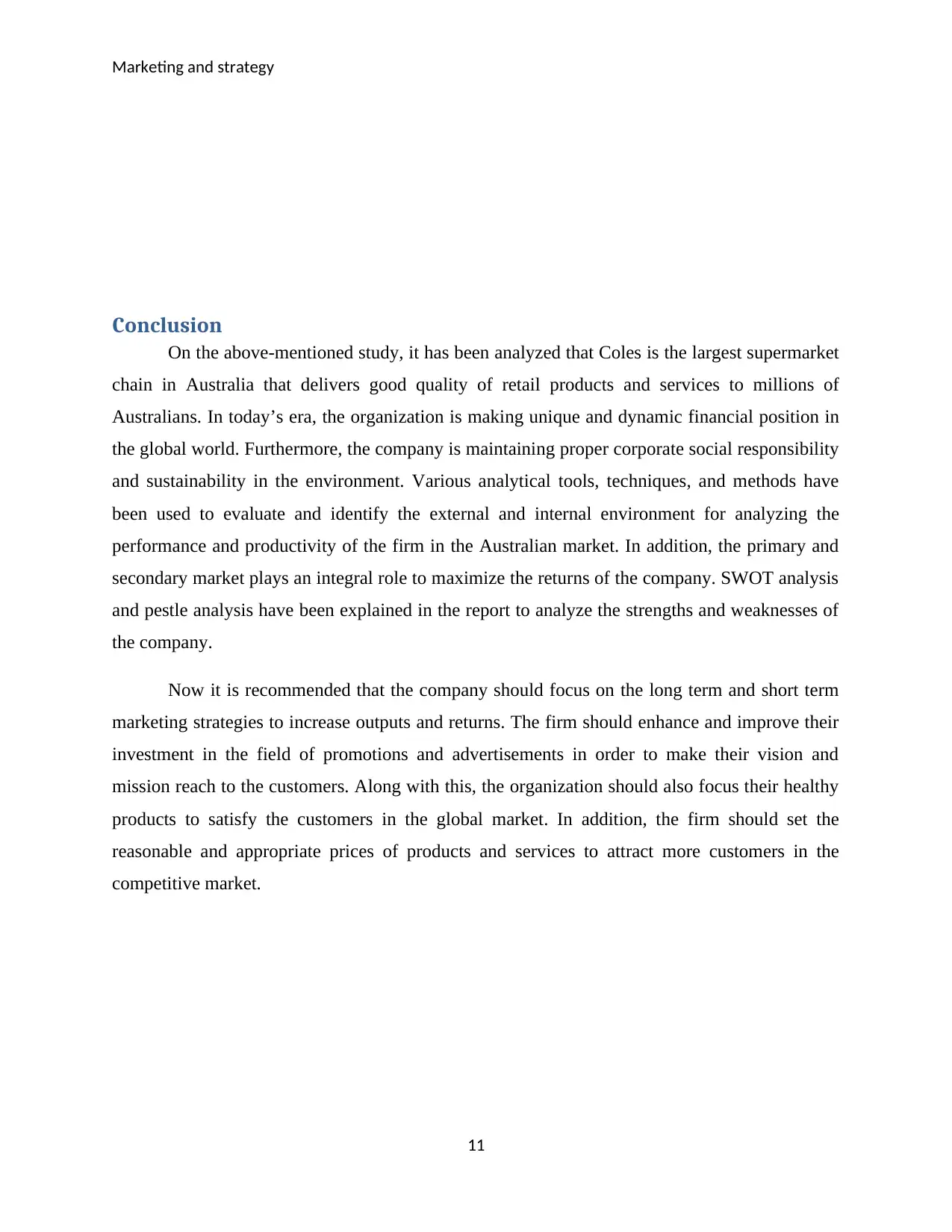
Marketing and strategy
Conclusion
On the above-mentioned study, it has been analyzed that Coles is the largest supermarket
chain in Australia that delivers good quality of retail products and services to millions of
Australians. In today’s era, the organization is making unique and dynamic financial position in
the global world. Furthermore, the company is maintaining proper corporate social responsibility
and sustainability in the environment. Various analytical tools, techniques, and methods have
been used to evaluate and identify the external and internal environment for analyzing the
performance and productivity of the firm in the Australian market. In addition, the primary and
secondary market plays an integral role to maximize the returns of the company. SWOT analysis
and pestle analysis have been explained in the report to analyze the strengths and weaknesses of
the company.
Now it is recommended that the company should focus on the long term and short term
marketing strategies to increase outputs and returns. The firm should enhance and improve their
investment in the field of promotions and advertisements in order to make their vision and
mission reach to the customers. Along with this, the organization should also focus their healthy
products to satisfy the customers in the global market. In addition, the firm should set the
reasonable and appropriate prices of products and services to attract more customers in the
competitive market.
11
Conclusion
On the above-mentioned study, it has been analyzed that Coles is the largest supermarket
chain in Australia that delivers good quality of retail products and services to millions of
Australians. In today’s era, the organization is making unique and dynamic financial position in
the global world. Furthermore, the company is maintaining proper corporate social responsibility
and sustainability in the environment. Various analytical tools, techniques, and methods have
been used to evaluate and identify the external and internal environment for analyzing the
performance and productivity of the firm in the Australian market. In addition, the primary and
secondary market plays an integral role to maximize the returns of the company. SWOT analysis
and pestle analysis have been explained in the report to analyze the strengths and weaknesses of
the company.
Now it is recommended that the company should focus on the long term and short term
marketing strategies to increase outputs and returns. The firm should enhance and improve their
investment in the field of promotions and advertisements in order to make their vision and
mission reach to the customers. Along with this, the organization should also focus their healthy
products to satisfy the customers in the global market. In addition, the firm should set the
reasonable and appropriate prices of products and services to attract more customers in the
competitive market.
11
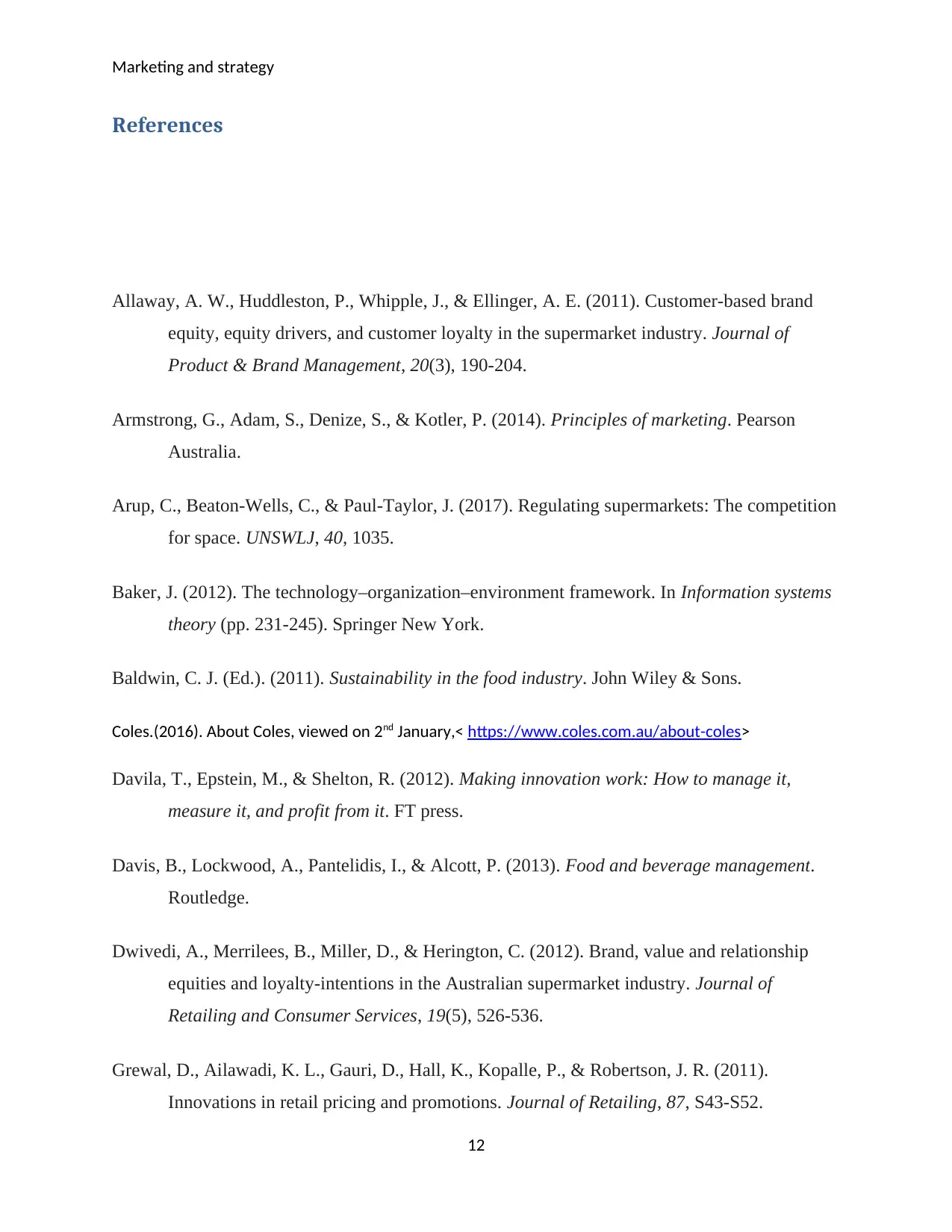
Marketing and strategy
References
Allaway, A. W., Huddleston, P., Whipple, J., & Ellinger, A. E. (2011). Customer-based brand
equity, equity drivers, and customer loyalty in the supermarket industry. Journal of
Product & Brand Management, 20(3), 190-204.
Armstrong, G., Adam, S., Denize, S., & Kotler, P. (2014). Principles of marketing. Pearson
Australia.
Arup, C., Beaton-Wells, C., & Paul-Taylor, J. (2017). Regulating supermarkets: The competition
for space. UNSWLJ, 40, 1035.
Baker, J. (2012). The technology–organization–environment framework. In Information systems
theory (pp. 231-245). Springer New York.
Baldwin, C. J. (Ed.). (2011). Sustainability in the food industry. John Wiley & Sons.
Coles.(2016). About Coles, viewed on 2nd January,< https://www.coles.com.au/about-coles>
Davila, T., Epstein, M., & Shelton, R. (2012). Making innovation work: How to manage it,
measure it, and profit from it. FT press.
Davis, B., Lockwood, A., Pantelidis, I., & Alcott, P. (2013). Food and beverage management.
Routledge.
Dwivedi, A., Merrilees, B., Miller, D., & Herington, C. (2012). Brand, value and relationship
equities and loyalty-intentions in the Australian supermarket industry. Journal of
Retailing and Consumer Services, 19(5), 526-536.
Grewal, D., Ailawadi, K. L., Gauri, D., Hall, K., Kopalle, P., & Robertson, J. R. (2011).
Innovations in retail pricing and promotions. Journal of Retailing, 87, S43-S52.
12
References
Allaway, A. W., Huddleston, P., Whipple, J., & Ellinger, A. E. (2011). Customer-based brand
equity, equity drivers, and customer loyalty in the supermarket industry. Journal of
Product & Brand Management, 20(3), 190-204.
Armstrong, G., Adam, S., Denize, S., & Kotler, P. (2014). Principles of marketing. Pearson
Australia.
Arup, C., Beaton-Wells, C., & Paul-Taylor, J. (2017). Regulating supermarkets: The competition
for space. UNSWLJ, 40, 1035.
Baker, J. (2012). The technology–organization–environment framework. In Information systems
theory (pp. 231-245). Springer New York.
Baldwin, C. J. (Ed.). (2011). Sustainability in the food industry. John Wiley & Sons.
Coles.(2016). About Coles, viewed on 2nd January,< https://www.coles.com.au/about-coles>
Davila, T., Epstein, M., & Shelton, R. (2012). Making innovation work: How to manage it,
measure it, and profit from it. FT press.
Davis, B., Lockwood, A., Pantelidis, I., & Alcott, P. (2013). Food and beverage management.
Routledge.
Dwivedi, A., Merrilees, B., Miller, D., & Herington, C. (2012). Brand, value and relationship
equities and loyalty-intentions in the Australian supermarket industry. Journal of
Retailing and Consumer Services, 19(5), 526-536.
Grewal, D., Ailawadi, K. L., Gauri, D., Hall, K., Kopalle, P., & Robertson, J. R. (2011).
Innovations in retail pricing and promotions. Journal of Retailing, 87, S43-S52.
12
⊘ This is a preview!⊘
Do you want full access?
Subscribe today to unlock all pages.

Trusted by 1+ million students worldwide
1 out of 13
Related Documents
Your All-in-One AI-Powered Toolkit for Academic Success.
+13062052269
info@desklib.com
Available 24*7 on WhatsApp / Email
![[object Object]](/_next/static/media/star-bottom.7253800d.svg)
Unlock your academic potential
Copyright © 2020–2025 A2Z Services. All Rights Reserved. Developed and managed by ZUCOL.





